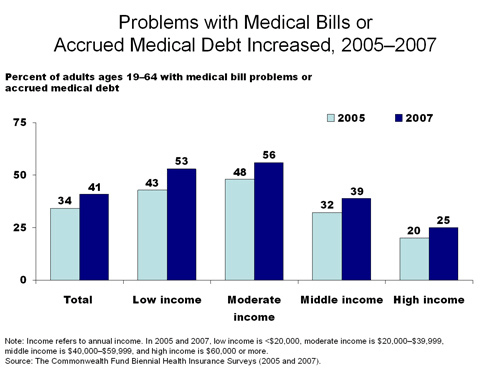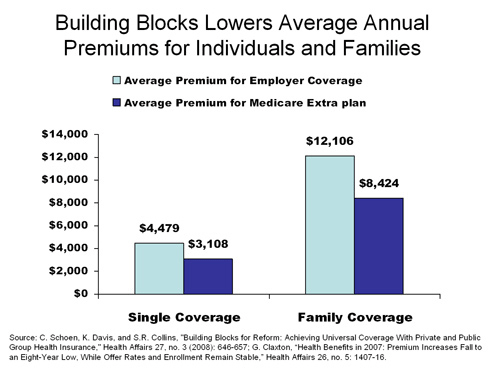The presidential candidates have responded to Americans' deep-seated concern about the shortcomings of the U.S. health system with two very different health reform proposals. A new series of articles published on the Web site of the health policy journal Health Affairs provides important analyses of the health plans of Senators Obama and McCain that merit close examination. As the articles reveal, the candidates are far apart on what they perceive to be the root causes of system failure and on their overall strategy for fixing a broken sector that consumes 16 percent of the gross domestic product, yet leaves 46 million uninsured and another 25 million working-age adults underinsured.
The September 16 online issue of Health Affairs includes a critique of Senator Obama's health reform plan by Joseph Antos and colleagues, a critique of Senator McCain's plan by Thomas Buchmueller and colleagues, and an article by Mark V. Pauly that explores how the candidates' proposals might be combined in a single compromise package.
I believe the kind of scrutiny of both plans that is seen in the Health Affairs articles is positive—so that when the public has made its choice, the winning candidate can put his team to work, using the best information available on what reforms are most likely to promote a high performance health system.
Correcting a Cost Estimate
In the interest of helping inform the debate, colleagues at The Commonwealth Fund and I developed a framework for a comprehensive approach to health care reform that is laid out in "Building Blocks for Reform: Achieving Universal Coverage with Private and Public Group Health Insurance," published in Health Affairs in their May/June 2008 issue. To support their argument that Senator Obama's plan is too costly, the critique by Joseph Antos and colleagues cites the estimated costs of the Building Blocks proposal, which has several features in common with Senator Obama's plan. However, Senator Obama's proposal differs in important respects—for example, it does not require adults to have insurance and it has not specified the level of income-related premium subsidies or income eligibility levels for Medicaid and the State Children's Health Insurance Program (SCHIP).
The authors' assertion that the Building Blocks plan would increase spending by $162 billion if it were operating in 2008 is misleading. The actual net cost to the federal budget in the article is $82 billion in 2008, after allowing for the recapture of funds now subsidizing care of the uninsured, employer contributions to coverage of workers, and assessments on providers that offset their enhanced payments for care of the uninsured and Medicaid beneficiaries. An accompanying issue brief notes how even this cost could be further reduced to $31 billion in 2008 by adopting a series of provider payment and health system reforms that have been supported, in principle, by both Senator McCain and Senator Obama. As a result, the nation could actually save $1.6 trillion over 10 years if health expansions are coupled with efforts to reform how the United States pays for health care, invest in better information systems, and adopt initiatives to improve public health. The debate is not furthered by implying that coverage for all Americans is unaffordable. If properly designed, universal coverage could improve overall performance of the health system, enhance value for what we are spending, and assure access to health care for all.
The Underlying Differences
Despite the general nature of the health proposals advanced by the candidates, the Health Affairs articles shed light on the issues underlying this debate: how health insurance coverage would be changed, how coverage would be made affordable, and how the delivery of health care services would be affected.
Senator McCain would provide refundable tax credits for the purchase of health insurance coverage—$2,500 for individuals and $5,000 for families. He would also count employer contributions to health insurance premiums as taxable income for families. As a result, some people would pay less than they now pay, and some would pay more. Buchmueller and colleagues estimate that roughly 20 million would lose employer coverage and 21 million would buy individual coverage—for a net reduction in the uninsured of one million. Over time, the numbers of uninsured would grow if the tax credit is indexed to general inflation rather than rising health care costs. Buchmueller's estimates are consistent with recent estimates from the Tax Policy Center at the Brookings Institution and Urban Institute.
By contrast, Senator Obama would provide income-related premium assistance to lower- and middle-income families—although the exact amounts are not specified—and expand coverage under Medicaid and the SCHIP. The Tax Policy Center makes a number of assumptions about these specifics and estimates his plan would cut the number of uninsured roughly in half.
Our Building Blocks proposal, which includes a mandate that everyone have health insurance, expands SCHIP to adults and children with incomes below 150 percent of the poverty level, and ensures that no one pays a premium in excess of five percent of income for those in the lowest tax brackets or 10 percent of income in the higher tax brackets. As a result, it covers an estimated 44 million uninsured out of an estimated 48 million uninsured in 2008. Even without offsetting system reform savings, $82 billion in federal budget outlays is an important investment in healthier children and workers, and key to ensuring financial security from medical bills for all families.
The Health Affairs articles also make clear the strategy each candidate would use to make coverage more affordable. Senator McCain would effectively deregulate the health insurance market by permitting individuals to purchase coverage in any state. This would provide a larger number of choices and include the option to select cheaper plans with more limited benefits. However, Buchmueller and colleagues point out that Senator McCain's approach could undermine consumer protections and state laws designed to provide a minimum level of coverage—as insurers are likely to charter in states where regulations are scarce, as credit card companies do now.
Senator McCain's philosophy is that consumers making cost-conscious choices would buy policies with leaner benefits. Higher out-of-pocket costs would also lead patients not to seek care for minor conditions. Antos and his coauthors say that the standard for benefits in Senator Obama's federal plan—now modeled on the plan available to members of Congress—should be reduced in order to hold down the costs of premiums and federal subsidies. But a skimpier plan is not the answer. A recent Commonwealth Fund report found that low- and even middle-income families are already experiencing difficulty paying medical bills and rising accumulated medical debt. In 2005, 34 percent of adults ages 18 to 64 said they had trouble paying medical bills or had accrued medical debt; by 2007, 41 percent of adults reported such problems.

Buchmueller and colleagues also note that coverage in the individual market typically costs $2000 more than employer coverage offering the same benefits. Pauly argues that many working families may prefer to keep coverage from employers, which generally has lower administrative costs, and suggests a compromise plan that would retain employer coverage but cap the amount of the premium excluded from income taxes.
Senator Obama has a different strategy for making coverage affordable. He would offer a public plan as well as private insurance plans through a national health insurance exchange and set rules for the sale of private insurance—such as requiring private insurance to cover healthy and sick enrollees on the same basis. Private plans would have a maximum ceiling on the share of premium for administrative costs and profits. Antos and colleagues, however, suggest that greater government regulation of insurers could have undesirable consequences and stifle innovation. They are also concerned that increased insurance regulation coupled with the creation of a "fallback" National Health Plan would undermine the employer market. But this has not happened in Massachusetts, which has expanded employer coverage and restrained premium growth since enacting health reform.
Offering small businesses and those without access to employer coverage the option of buying a public plan modeled on Medicare is an intermediate approach. If the government can provide better coverage at lower cost, it would attract employers and the uninsured. Our Building Blocks proposal, which like Senator Obama's proposal includes a public plan option, found that actuarial premiums for families in the public plan option were 30 percent below premiums now typical in the employer-sponsored insurance market. Such competition could induce private insurers to compete on quality and efficiency—for example by using networks of hospitals and physicians that provide superior care at lower cost.

Changing the Health System
While the candidates differ markedly on their approach to health insurance coverage, as Mark Pauly describes in his Health Affairs article, there are promising features in both McCain and Obama's plans; both would expand the use of health information technology and expand research on the comparative effectiveness of different prescription drugs. In addition, both Senator McCain and Senator Obama would allow importation of prescription drugs, reducing the costs of drugs.
Most importantly, both Senator McCain and Senator Obama support ensuring that Americans have access to a physician practice or clinic that serves as a medical home that is accessible to patients 24/7. Almost three in four Americans have problems with access to primary care on nights and weekends and even getting an appointment or phone call returned during the day. A medical home would also help patients navigate a complex health care system and be accountable for providing preventive care and chronic disease management. The Commonwealth Fund Commission on a High Performance Health System national scorecard finds that today, only half of Americans are up-to-date with preventive care and millions more do not have their chronic conditions adequately controlled.
To help make the system more responsive to patients, both presidential candidates would change the way doctors and hospitals are paid to reward those that achieve excellence in care and keep patients healthy and out of the hospital, while cutting out unnecessary services that waste dollars and patients' time. A recent Commonwealth Fund survey of the public found that a third had experienced duplicate tests or doctors recommended services or treatment that were of little health benefit.
This is the most important aspect of the reform proposals—but one which has received very little attention. The Health Affairs authors are skeptical about magic "silver bullets" that will solve our cost problem, improve quality, and reduce medical errors. But other countries have succeeded in getting better outcomes at lower cost. Candidates should be pressed for more details on how they propose to put the U.S. on the road to a high performance health system—and what approaches now in practice in parts of the U.S. or around the world are workable options for the U.S. as a whole.
The Health Affairs articles do highlight some common ground in candidates' aspirations to improve the efficiency of the system and the quality of care. Our hope is that, post-election, the focus will turn as quickly as possible to building concretely on the areas of agreement and work from there to achieve the health system reform that the country needs so desperately. We cannot afford to continue on our current course, and indeed must change direction to ensure affordable health care for all Americans.
As always, I'm interested in your feedback. Please take advantage of our commenting feature by clicking on the "Post a Comment" button. Select comments will be published on this page.

Written with the assistance of Martha Hostetter.


